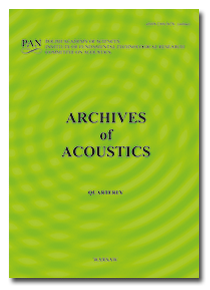Archives of Acoustics,
37, 4, pp. 405–409, 2012
Test Signal Selection for Determining the Sound Scattering Coefficient in a Reverberation Chamber
The paper focuses on the problem of test signal selection in determining the sound scattering coefficient
in accordance with ISO 17497-1. Research shows that the use of MLS signal is preferred in this procedure.
The sine sweep signal, despite its advantages, presents certain limitations if the sample is moving during
measurement. An attempt has been made to develop a method that allows for minimization of error,
demonstrating the dependence of the obtained values of the sound scattering coefficient on the rotational
speed of the turntable and type of test signal. Conditions for the application of the sine sweep signals in
continuous and discrete measurements were defined.
in accordance with ISO 17497-1. Research shows that the use of MLS signal is preferred in this procedure.
The sine sweep signal, despite its advantages, presents certain limitations if the sample is moving during
measurement. An attempt has been made to develop a method that allows for minimization of error,
demonstrating the dependence of the obtained values of the sound scattering coefficient on the rotational
speed of the turntable and type of test signal. Conditions for the application of the sine sweep signals in
continuous and discrete measurements were defined.
Keywords:
Schroeder diffusers; scattering; MLS; sine sweep
Full Text:
PDF
Copyright © Polish Academy of Sciences & Institute of Fundamental Technological Research (IPPT PAN).





